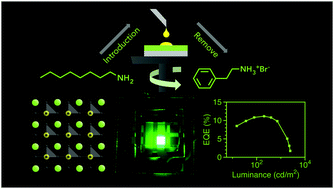Surfacial ligand management of a perovskite film for efficient and stable light-emitting diodes†
Abstract
Metal halide-based perovskite nanocrystals, as promising materials in light-emitting diodes (LEDs), have recently attracted considerable attention for their efficient charge transport properties, high color purity, and tunable bandgap over the entire visible spectral range. However, the poor stability and high surface roughness of halide-based perovskites are preventing them from wide applications in lighting and displays. Here, we report a facile method to obtain efficient and stable green-emitting perovskite light-emitting diodes (PeLEDs) by treating the surface of a perovskite film with octylamine solution. The luminescence efficiency, color purity, and light-emitting device stability were confirmed to be improved by the analysis of the morphology of the perovskite thin film and the photoelectric properties of the ligand-managed PeLEDs. The EQE of green CsPbBr3 PeLEDs increased from 7.0% to 11.1% via the surface ligand management. Therefore, the studies of this work will be promising in improving the efficiency and stability of PeLEDs. Thus, we expect these results to facilitate the research of perovskite-based light-emitting diodes for the new generation of lighting and display technologies.



 Please wait while we load your content...
Please wait while we load your content...